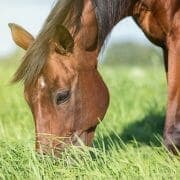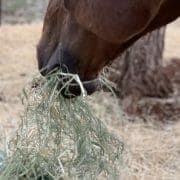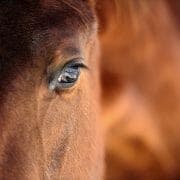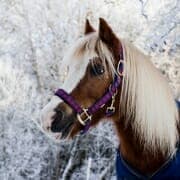Forage vs. Fibre
What’s the Difference in Your Horse’s Diet?
Horse owners often hear the words forage and fibre used interchangeably — but while they’re closely related, they don’t mean exactly the same thing. Understanding the difference helps you make better feeding decisions and ensure your horse’s diet supports optimal gut health, performance, and overall wellbeing.
Forage: The Foundation of the Equine Diet
Forage is a broad term to describe the edible plant material, composed mainly of leaves and stems, that your horse eats. Forage sources include pasture, hay, haylage and chaff. Horses have a minimum forage intake of 1.5% of bodyweight in dry matter per day.
Forage that comes from non-overgrazed pasture, hay or haylage is referred to as “long stem forage”, and is essential for the foundation of a horse’s diet. Long stem forage is defined as being more than 2 inches (5 cm) in length and it’s the form of forage that horses have evolved to eat and that most supports natural grazing behaviour.
Short stem forage options, which include chaff (chopped hay) and some hay cubes, provide some benefits of long stem forage; however, they often don’t support natural grazing behaviour and have reduced chewing time compared with long stem forage. In horses that cannot eat long stem forage due to dental abnormalities, these should be used to replace long stem forage.
Long stem forage is essential for several reasons:
- It provides the bulk that keeps the digestive system full (reducing the risk of colic), moves dirt and sand through the gut and helps maintain hydration (fibre soaks up and holds water in the hindgut).
- It’s the sheer volume of food source and housing that keeps the hindgut microbes healthy and active.
- It supplies much of the horse’s daily energy, protein, vitamins, and minerals.
- It satisfies your horse’s instinctive need to chew and graze for many hours a day — reducing stress and the risk of ulcers or behavioural issues.
In short, long stem forage is the main ingredient in every good equine diet.

Fibre: The Nutrient Found in Forage (and Other Feeds)
Fibre refers to the structural carbohydrates found in plants, which are mostly cellulose, hemicellulose and lignin. Other types of fibre found in plants can include pectins, gums and mucilage.
Think of fibre like an essential nutrient to the horse, but the exact fibre requirement for horses is unknown and instead, we supply enough fibre in the diet by looking at the more broadly used minimum forage intake.
Horses utilise fibre (via microbial fermentation in their hindgut) to produce energy (and many other by-products) required for body function, maintaining condition and for performance.
Pasture, hay and haylage aren’t the only fibre sources in horse’s diets, with other fibre sources and now commercial feeds based on these fibre sources becoming popular. Often called “high energy fibres” or “super fibres” because they provide good amounts of digestible energy while still supporting healthy gut fermentation — these are excellent for horses needing extra calories without the starch load from grains. Examples of these include beet pulp, soybean hulls, lupin hulls, copra meal and lucerne leaf meal or pellets.
Why the Difference Matters
Not all forage and fibre sources can be used interchangeably in equine diets. For example, long stem forage plays a really important role in maintaining digestive function and supporting natural grazing behaviour. We cannot substitute 100% of this forage with other fibre sources such as beet pulp or legume hulls, despite them both being a source of ‘fibre’ — an essential nutrient.
The types of fibre these different forage sources contain are different and act differently in the digestive system. Pasture, hay and haylage are mostly made up of cellulose, hemicellulose and lignin. Lignin is unable to be digested via microbial fermentation yet plays an important functional role, keeping the gut full, holding water and moving dirt through the system. In contrast, beet pulp, legume hulls and even leafy lucerne provide very little lignin, therefore cannot perform the same job.
Instead, these fibres are composed of highly digestible fibre, namely pectin, gums and mucilage. When they enter the hindgut, they are quickly fermented by microbes and very little of this feed is carried through the remainder of the digestive tract. The result is likely to be less gut fill, decreased water holding capacity (hydration) and increased amount of dirt or sand collecting in the gut.
The other key differences between the forage and fibre sources, is the amount of chewing required by your horse to process them into small enough particles to swallow. Stating the obvious, long stem forage takes longer to chew and therefore has the greater production of saliva. Saliva plays an essential role in maintaining stomach health, maintaining the pH and reducing the risk of gastric ulcers. We should always prioritise feeding long stem forage to maximise the time horses spend eating and mimicking that natural grazing behaviour.
Short stem forage and high energy fibre sources can be beneficial in diets for horses, especially horses with higher energy demands that don’t tolerate larger amounts of sugar and starch in diets, but these fibre sources also provide fibre (a nutrient) diversity in diets which is beneficial for hindgut microbial diversity and resilience.
FeedXL Tip
When using FeedXL, always enter your long stem forages such as pasture, hay and/or haylage into your horse’s diet first. Aim to feed a minimum of 1.5% of your horse’s bodyweight in long stem forage per day. Once you’ve achieved this, you can go ahead and add to the diet any other forage (chaff, hay cubes etc.) and high energy fibre products on top of this (like you would any commercial feed).
As well as aiming to feed at least 1.5–2% of your horse’s bodyweight per day in forage, feeding a variety of fibre sources is recommended.
In Summary
| Long-Stem Forage | Short-Stem Forage | High Energy Fibre | |
|---|---|---|---|
| Examples | Pasture, hay and haylage | Chaff, chopped hay, some hay cubes | Beet pulp, soybean hulls, lupin hulls, copra meal, lucerne leaf meal |
| Chewing Time | Longer chewing time | Less chewing required | Minimal chewing time |
| Saliva Production | High (due to extended chewing) | Lower | Minimal |
| Behavioural Enrichment | Provides natural feeding behaviour | Less stimulating | N/A |
| Importance in Diets | Essential | Optional | Beneficial |
| Purpose in Diets | Encourages chewing over majority of day Provides gut fill Supports natural grazing behaviour Major source of nutrients and fibre (energy) in diets |
Improve palatability of feed Replacement for long-stem forage in horses with dental issues Lucerne/alfalfa products may help with pH buffering of starch fermentation from grain-based feeds in stomach |
Energy source Provide fibre diversity |
Healthy horses start with a diet based on plenty of good-quality long stem forage.
FeedXL members — now’s the perfect time to double-check your horse’s diet.
Log in and review your forage and fibre balance »
Not using FeedXL yet?
Join today to start building scientifically balanced diets for your horse »









